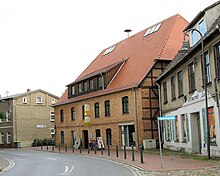Schwaan artists' colony
The Schwaan artists' colony was formed at the end of the 19th century in the small town of Schwaan between Rostock and Güstrow . As with other artist colonies, in this case too the desire to escape from urban civilization into idyllic nature was the trigger for the formation of the colony.
As early as 1860, artists such as Otto Dörr (1831–1868), Eduard Ehrke (1837–1911) and Carl Malchin (1838–1923) discovered the landscape around Schwaan, which was shaped by the rivers Warnow and Beke , as a motif for their pictures. At the suggestion of Franz Bunke (1857–1939), who was born in Schwaan, the place developed into a real artists' colony. Bunke had initially learned from Paul Tischbein and Theodor Rogge in Rostock and then via Berlin to the Weimar School of Painting , where he became a student of Theodor Hagen and in 1886 became a professor himself. From 1892 onwards, Bunke spent the period from spring to autumn in Schwaan to paint and brought along numerous of his Weimar students and colleagues during these visits, including Paul Baum , Paul Riss , Richard Starcke , Arno Metzeroth , Rudolf Holzschuh and Otto Tarnogrocki . Alfred Heinsohn had belonged to the Schwaan artist group since 1902 and settled here. Some Schwaaner were also taught by Bunke, among them Peter Paul Draewing and Rudolf Bartels , who later also studied in Weimar. So all artists were influenced by Franz Bunke and Theodor Hagen, who, turning away from the academic style, taught working in front of nature.
The highlights were the joint exhibitions. The first such exhibition took place in 1904 in the Rostock Museum. Mutual visits took place with the Ahrenshoop artists' colony . With and after the First World War , the Schwaan artists' colony gradually disintegrated and was forgotten.
An important collection of the works of the artists' colony has been housed in the building of the old watermill in Schwaan since 2002. The permanent exhibition focuses on the works of Franz Bunke, Rudolf Bartels, Peter Paul Draewing and Alfred Heinsohn.
literature
- Johann Joachim Bernitt: Ahrenshoop and Schwaan. A century of north German artist colonies. Atelier in the farmhouse, Fischerhude 1992, ISBN 3-88132201-9 .
- Stephan Kohls, Ute Kümmel: Dreamy, discovered, forgotten - the Schwaan artists' colony. In: Melanie Ehler (Ed.): Retreat to Paradise. The artist colonies Worpswede - Ahrenshoop - Schwaan. Lukas, Berlin 2001, ISBN 3-931836-62-2 , pp. 41-48.
- Lisa Jürß: The Schwaan artists' colony. Atelier in the farmhouse, Fischerhude 2002, ISBN 3-88132-295-7 .
Web links
- Website of the Schwaan Art Museum
- North German artist colonies - association of the places Ahrenshoop, Hiddensee and Schwaan
